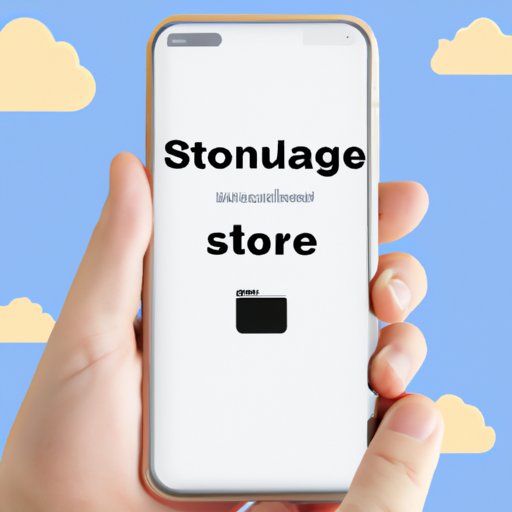
Introduction
iCloud storage is a crucial aspect of managing your Apple devices, as it helps you store important data and information that can be easily accessed across different devices. Over time, this storage can become cluttered with unnecessary backups, photos, and files. This can lead to a range of issues such as slowing down your device and a lack of space. In this article, we will explore step-by-step how to delete iCloud storage, identify common reasons to delete it, and provide useful tips to manage it efficiently.
Step-by-Step Guide to Deleting iCloud Storage
The first step to create more iCloud storage space is to learn how to delete unnecessary backups. From there, you can work on deleting photos, messages, and other data to further reduce storage usage. In this section, we will guide you on how to delete your iCloud storage step by step.
Step 1: Turn off iCloud backups for your apps
The latest version of iOS has an option to customize your backups. Go to Settings > [Your Name] > iCloud > Manage Storage > Backups. Here, you’ll see a list of apps that store data in the iCloud. You can turn off the app backups of the apps that you don’t require them on by tapping on the toggle next to the app.
Step 2: Clear up space by deleting unwanted photos
If your iCloud storage is mostly occupied by photos, you can free up some space by deleting them. Open the Photos app on your Apple device and select the photos you want to delete. Make sure to check the “Recently Deleted” folder to permanently erase them from your iCloud storage as well.
Step 3: Manage documents
Deleting unwanted documents and files from the iCloud can also help you manage your iCloud storage better. This can be done from the Files app, where you can select the file you want to delete and tap on the “Delete” option.
Step 4: Turn off iCloud Photo Library
If you are using iCloud Photo Library, you can turn it off to free up some space. To do this, go to Settings > [Your Name] > iCloud > Photos. Here, you can turn off “iCloud Photo Library” and optimize storage on your device. This will also delete your original iPhone/Samsung Galaxy photos from your iCloud storage while keeping the optimized versions of the photos on your device.
Troubleshooting Tips:
If you encounter issues while deleting your iCloud Storage, it is essential to troubleshoot the problem accordingly. Often, restarting the device or logging out of the iCloud account may help to fix any issues that you may face.
Common Reasons to Delete iCloud Storage
People commonly delete iCloud storage when they are running out of storage space, they have too many backups of unused data, or to free up space for new data. With cloud storage being an essential aspect of modern device management, it is crucial to keep the iCloud storage organized and relatively clutter-free.
Tips for Managing iCloud Storage Efficiently
Efficient management of your iCloud Storage can help you avoid running out of storage space or facing any other device issues. Here are some crucial tips for managing your iCloud storage better:
Tip 1: Delete old backups: Regularly delete old backups of the apps you no longer use to free up some space.
Tip 2: Turn off automatic backups: If you don’t need to back up your apps, turn off automatic backups for specific apps to save space.
Tip 3: Use “Optimize Storage”: When possible, use the “Optimize Storage” option to free up iCloud space.
Tip 4: Use “Low-Quality Image Mode”: This option compresses image sizes and is an excellent way to free up space on your device and iCloud storage.
Identifying Storage-Hogging Apps
To manage your iCloud storage effectively, you need to know which apps are using the most space. When you know this, you can selectively delete specific apps to free up more storage space. It’s easy to check which apps are using up the most storage space on your device by going to “Settings” > “General” > “Storage & iCloud Usage”.
iCloud Storage vs. Local Storage
If you feel like you’re running out of iCloud storage space constantly and are uncertain if it’s the right option for you, there are many alternative options available. These days, many people prefer local storage as it does not have any drawbacks such as regular fees, data retrieval issues, or performance latency. However, with local storage, it becomes increasingly challenging to access data from different devices.
Alternatives to iCloud Storage
There are many alternatives to iCloud Storage, and some of the top options include services like Google Drive, Dropbox, and OneDrive. These cloud storage services offer similar features to iCloud Storage but can be better suited for people with different device needs. If you want to move your data from iCloud to another cloud storage service, the easiest way to do this is by downloading the data on the iCloud Drive and then uploading it to your desired cloud storage service.
Best Practices for Deleting iCloud Storage
It is essential to follow best practices while deleting your iCloud Storage. Here are some things to keep in mind:
Backing up data: Before you start deleting your iCloud Storage, make sure that you back up the data into another location.
Check for unused apps: Remove the backups of apps that you do not use, as this will create more space on your iCloud storage.
Conclusion
Deleting iCloud storage can be an easy process if you follow the steps listed in this guide. We’ve covered all the crucial topics necessary for helping you manage your device storage efficiently, from deleting unwanted backups to identifying storage-hogging apps. iCloud storage space can be precious, and it pays off to manage it correctly. Now it’s time to take these steps and create more space on your iCloud storage.




